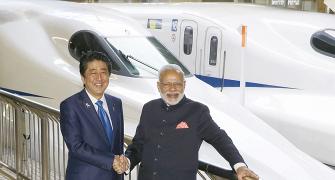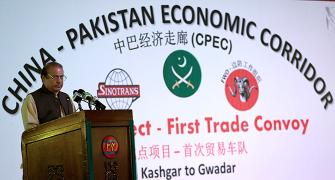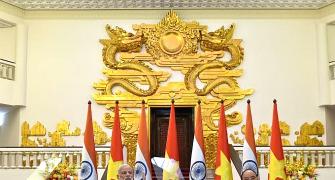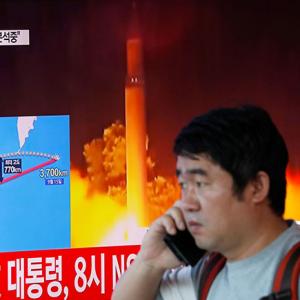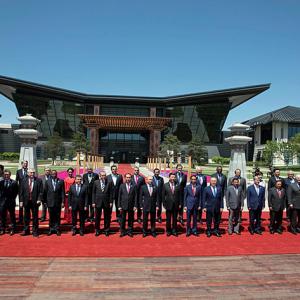China sees India and Japan's 'North East Road Network Connectivity Improvement Project' as a challenge to its OBOR, says Rajaram Panda.
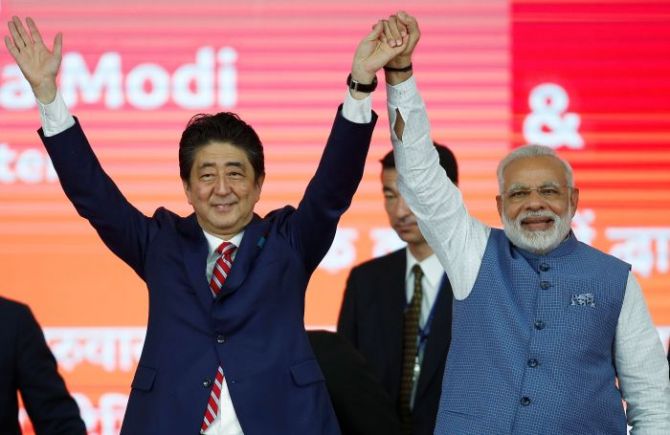
China is irked at the growing bonhomie between India and Japan.
This became demonstrably clear when China expressed its discomfort by reacting to the India-Japan understanding for collaborative initiatives to develop India's northeastern region when Japanese Prime Minister Abe Shinzo visited India on September 13-14, 2017.
While China itself continues to show its aggressive posture in regional territorial issues by making dubious claims where none exist, in utter disrespect to the sensitivities to the adversarial countries, it gets paranoid when other countries in the region reach an understanding over issues that are in their mutual interests.
Seen from a larger perspective, a rising China poses a clear threat to the fragile international system dominated so far by the United States, or at least it will be a threat, if it is denied space to reshape the system on its own terms.
China's reaction to the agreement reached between Abe and Prime Minister Narendra D Modi to develop the northeastern states is a demonstration of this larger narrative.
Though several agreements were signed in a variety of areas, I analyse only the objectives of the understanding between India and Japan to develop the northastern states and why China is sensitive about this.
One key takeaway of the 12th annual summit in Gandhinagar was the signing of a Memorandum of Understanding to set up the India-Japan Act East Forum which could complement India's Act East Policy with Japan's Free and Open Asia-Pacific strategy.
Seen in the backdrop of China's One Belt One Road initiative, the significance of this India-Japan initiative cannot be overlooked.
The broad objective behind this is to enhance connectivity and promote development projects in the northeast region in an efficient and effective manner.
Not many are aware that Japan has historical links with India's northeast.
During World War II, Japanese forces fought the British in Manipur. There is a cemetery in Imphal of those Japanese soldiers who died in the war. Many Japanese visit the cemetry to pay homage.
During a visit to Imphal in 2013, I was surprised to see how beautifully the cemetery is maintained.
Such emotional connect comes handy for the Japanese to collaborate with India to jointly build a bridge with Southeast Asia.
This region is India's only gateway to the ASEAN (Association of Southeast Asian Nations) countries and therefore connectivity here is hugely important.
Collaborating with Japan, therefore, is a major thrust area to further the Act East policy and lead to economic prosperity of the entire Asian region.
Japan's economic footprint in Southeast Asia is already rooted and joining hands with India could make only it more robust.
The agreement on Japanese loans and aid for highway development can complement India's connectivity in Bangladesh and Myanmar, leading up to Vietnam, Cambodia and Laos.
This initiative could also put other initiatives such as BBIN (Bangladesh, Bhutan, India and Nepal), and BIMSTEC (Bay of Bengal Initiative for Multi-Sectoral Technical and Economic Cooperation) Motor Vehicle Agreements on the fast track.
As per the agreement, Japan shall provide a loan of Rs 2,239 crore (Rs 22.39 billion) for the 'North East Road Network Connectivity Improvement Project' to improve National Highway 40 and construct a bypass on NH-54 in the northeast.
It is hoped that the project could be the precursor to improving intra-regional and international connectivity and foster economic development in the region.
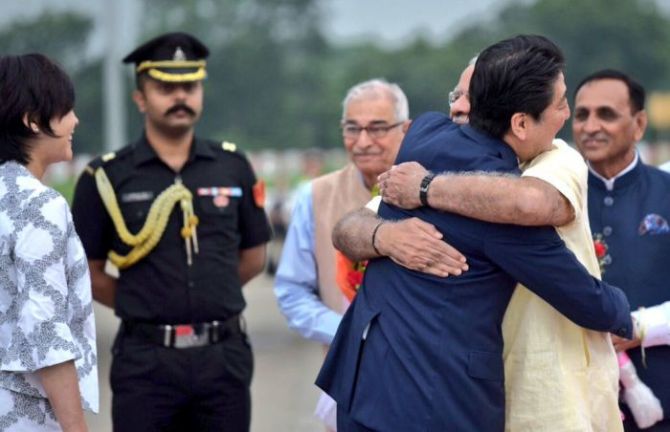
Photograph: Kind courtesy @MEAIndia/Twitter
China takes a critical view of this India-Japan joint initiative and sees it as a challenge to its OBOR.
It criticises Japan for building an informal economic alliance with India and engaging in projects to develop the ASEAN countries.
China, however, overlooks the fact that this India-Japan initiative is a part of a larger project of developing a corridor that was conceived in 2016 for the Indo-Pacific region with the aim of extending it to Eastern Africa under the Asia-Africa Growth Corridor.
This was conceived as an alternative to China's OBOR which India and Japan see as lacking transparency and solely dictated by China's interests.
Both India and Japan are convinced that by improving connectivity between Asia and Africa, the larger objective of achieving regional prosperity could be made easier.
It is for this reason Modi and Abe agreed to seek synergy between India's Act East policy with Japan's Expanded Partnership for Quality Infrastructure by closely coordinating, both bilaterally and with other partners, for better regional integration.
Improving connectivity and developing industrial networks based on the principles of mutual consultation and trust are defined as the appropriate means to pursue.
Such is not the case with China's OBOR initiative which is suspected to have always some hidden agenda.
It is not that Japan has no presence in northeastern India.
Japan is already engaged with a variety of development projects, ranging from connectivity, infrastructure, electricity, water supply and sewage, forest resource management and biodiversity.
The historical connection also makes way for developing relations in the cultural domain.
The newly created Coordination Forum shall help in proper coordination between the two countries for building a robust India-Japan partnership relating to this region.
With this in view, Japan's Ambassador to India Kenji Hiramatsu took a delegation of 38 Japanese companies based in New Delhi to Imphal on May 20-21 to encourage investments in the region.
The ambassador's visit marked the commemoration of the 73rd anniversary of the Battle of Imphal fought between the Japanese army and the Allied forces in 1944.
Against this symbolism of 'historic emotional links', India-Japan bonhomie to develop this geographical part of India is logical.
No sooner was the MoU reached, China warned third parties against meddling in the boundary dispute with India, mentioning Arunachal Pradesh in an apparent response to the plan between India and Japan to invest in infrastructure projects in the region.
China ignored the fact that the joint statement did not specifically refer to Arunachal Pradesh and yet it raised objections.
China's foreign ministry spokesperson Hua Chunying mentioned that the territory in the 'eastern section', which China refers to large parts of Arunachal Pradesh, which it calls southern Tibet as disputed and therefore has objections of any third party's involvement.
Hua further said this is a bilateral dispute and both countries are trying to seek a solution through negotiation that is acceptable to both sides.
Since the border in the eastern section of the boundary has not been totally delimited, a third country should not get involved in any manner, China says.
The India-Japan joint statement had only referred to cooperation to develop the northeastern states as a 'concrete symbol of developing synergies' between India's Act East Policy and Japan's Free and Open Indo-Pacific Strategy.
But Beijing is opposed to any foreign investment, including from Japan, in the 'disputed areas'.
China wrongly fears that India and Japan are forming a sort of alliance against it and reminds that the two countries should limit their relationship only to partnership conducive to peace in the region.
Does China feel insecure with India and Japan coming together to build a partnership to restore order in a region where it has become increasingly assertive?
This seems to be so as its attempts to expand its strategic space are being checkmated by the other two nations.
If China expects that it can have a free rein in its expansionist design, it would be a folly to believe that others would make no effort to counter such an effort.
This did not deter China's nationalistic Global Times to say that Japan with its 'narrow-minded' outlook is joining with India to 'encircle China'.
India remembers, however, that Japan was the only major power that openly took a position favouring India in the recent military standoff with China at Doklam and it was natural that China was the necessary subtext of discussion between Modi and Abe in Gandhinagar.
There is substantial convergence in the way they see the rise of China, balance of power in the Asia Pacific and cooperation between countries in the African continent and closer region in Southeast Asia.
This is being seen in India-Japan joint initiatives through quality infrastructure projects, not only in the African continent but also in India's northeast, the footprint of which is to counter China's infrastructure development spree in many parts of the world cannot be missed.
Dr Rajaram Panda is currently the Indian Council for Cultural Relations India Chair Visiting Professor at Reitaku University, Japan.
The views expressed are the author's own and do not represent either of the ICCR or the Government of India.

